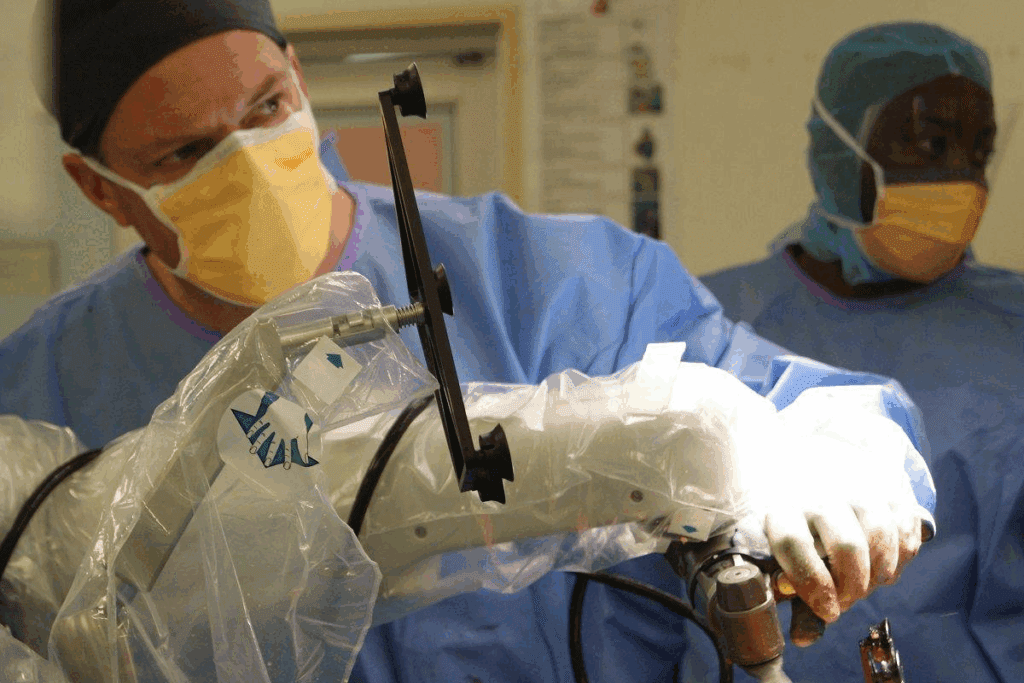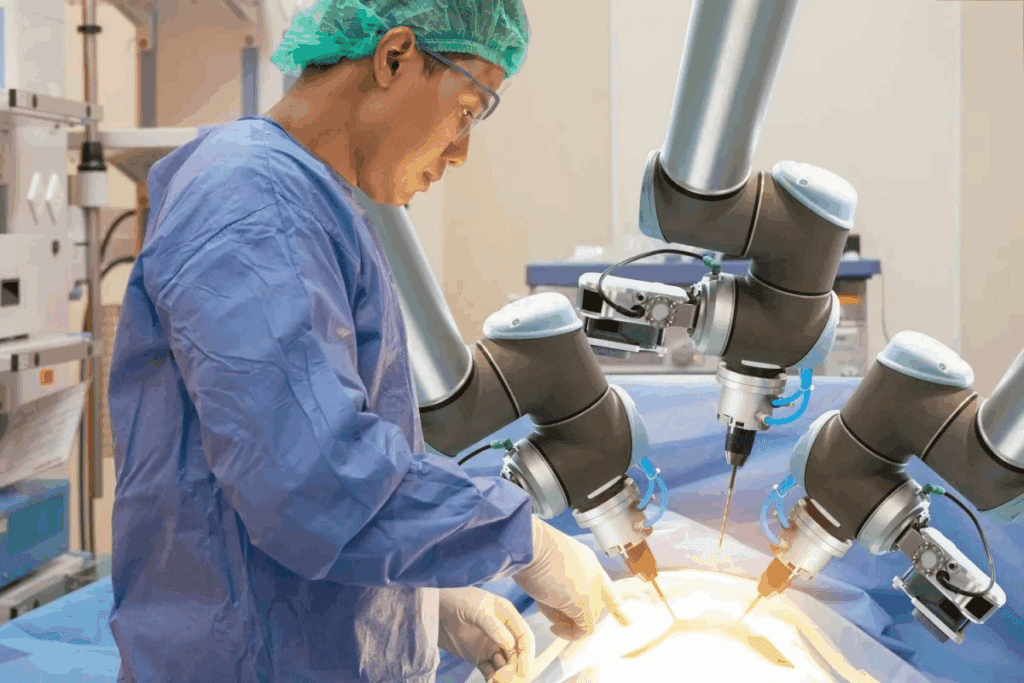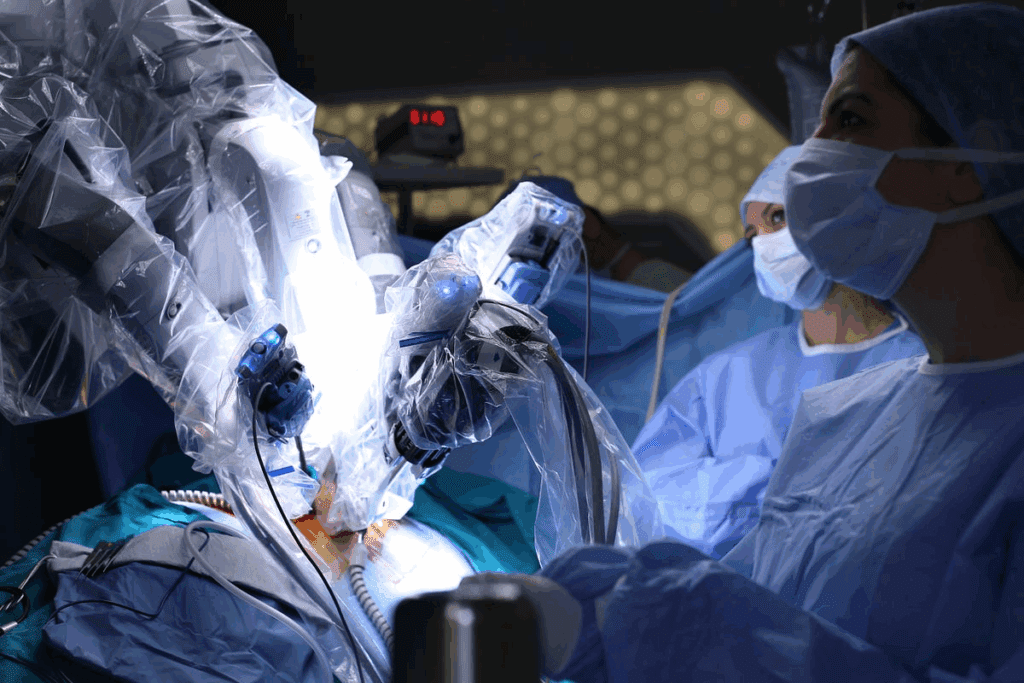Last Updated on November 27, 2025 by Bilal Hasdemir

Choosing to have a robotic hysterectomy is a big step. Knowing how to recover is crucial to a smooth healing process. Studies show that following a well-designed recovery plan can reduce recovery time. Healing time and bed rest after robotic hysterectomy. Learn recovery duration, activity restrictions, and when to resume normal life.
The days right after surgery are very important for a quick and successful recovery. We aim to help you understand what to expect. This includes how long you should rest in bed and the overall recovery timeline.

Robotic hysterectomy is changing how surgeons remove the uterus. It’s a precise and less invasive method compared to the old ways. This new technique is getting a lot of attention for its promise to better patient results and faster healing.
A robotic hysterectomy is a new kind of surgery for removing the uterus. It uses a robotic system for the job. The surgeon makes small cuts in the belly and puts in the robotic arms and a camera.
The surgeon then controls the robotic arms from a special console. This lets them move very precisely and see everything clearly.

Robotic hysterectomy is different from the old way because it uses smaller cuts. This means less chance of problems, less blood loss, and a faster recovery. The robotic system also gives a 3D view and better control, making the surgery more precise.
Robotic surgery has many benefits. It means less pain after surgery, shorter hospital stays, and fewer infections. The robotic system’s precision helps the healing process, too.
Also, the small cuts mean less scarring and a quicker return to daily activities.
| Benefits | Robotic Hysterectomy | Traditional Hysterectomy |
| Incision Size | Small | Large |
| Recovery Time | Quicker | Longer |
| Blood Loss | Minimal | Significant |
| Risk of Complications | Lower | Higher |
Getting ready for a robotic hysterectomy involves several important steps. These steps can greatly affect your surgery and how you recover. We aim to help you through this time with clear guidance and care.
You’ll have many tests and talks before your surgery. These steps are key to making sure you’re a good fit for the surgery. They also help find any health issues that might affect your surgery or healing duration.
Your healthcare team will help you through these steps. You might have blood tests, imaging, and a look at your medical history.
The day before surgery is critical. You need to get ready both physically and mentally. Your healthcare team will give you specific instructions, like what to eat and take, and other preparations.
It’s also wise to get your home ready for your recovery. Stock up on essentials and arrange for help if you need it.
Knowing what to bring to the hospital can make things easier. You’ll need ID, insurance, and medical records. Bringing comfortable clothes and personal items can also help.
We’ll give you a detailed list of what to bring. This way, you can focus on your surgery and time to heal without worry.
By following these steps and working with your healthcare team, you can have a successful surgery. Your active role in these preparations is key to a smooth recovery. It helps you get back to your normal life as quickly as possible.
Recovering from a robotic hysterectomy is key to avoiding problems and healing well. Our medical team watches your progress closely to help you recover smoothly.
The first 24 hours are vital for managing pain and avoiding issues. We focus on keeping you comfortable. Our team will also check for any complications and guide you on moving safely.
Key aspects of the first 24 hours include:
How long you stay in the hospital after a robotic hysterectomy varies. Most patients go home in a few days. The exact time depends on how quickly you recover and if any problems arise.
| Recovery Phase | Typical Hospital Stay |
| Uncomplicated recovery | 1-3 days |
| Complications present | 3-5 days or more |
At first, you might not be able to move much. But it’s important to move gently to avoid blood clots and help your body heal. Our team will show you how to move safely while in the hospital.
Knowing what to expect right after surgery helps you prepare for a good recovery. Our team is dedicated to giving you the care and support you need during your healing.
Knowing how long to rest in bed after a robotic hysterectomy is key. This rest time is important for healing and avoiding complications.
Doctors generally recommend 1–2 days of initial bed rest after a robotic hysterectomy. They often recommend 1-2 days of rest right after surgery. During this time, patients should not do too much and avoid hard tasks. But how long you need to rest can depend on your doctor and your health.
Several things can change how long you need to rest after a robotic hysterectomy. These include:
Going from bed rest to doing a bit more should be guided by doctors. Starting with light activities can help avoid problems like blood clots and aid in healing. Always follow your healthcare team’s advice on when and how to start doing more.
Understanding what affects how long you need to rest and following the doctor’s orders can help you recover faster. It’s important to find the right balance between resting and doing a bit more to get the best results.
Knowing how long it takes to recover from a robotic hysterectomy is key. The healing process has different stages. These include internal healing, external incision healing, and hormonal stabilization, each with its own time frame.
The body heals internally at its own pace. A lot of healing happens in the first few weeks. The initial healing phase is critical. It’s important to follow post-operative instructions carefully.
We suggest eating a balanced diet and drinking plenty of water. This helps the healing process.
External cuts from the surgery usually heal in a couple of weeks. Proper wound care is essential to avoid infection and aid healing. Keep the incision sites clean and dry.
Follow any specific care instructions from your healthcare team.
Hormonal balance can take longer, depending on your health, age, and any medical conditions. Patience and monitoring are important during this time. Regular check-ups with your healthcare provider are recommended.
The time it takes to heal from a robotic hysterectomy varies. Your health, any other health issues, and following post-operative care can affect your recovery time. By understanding these factors and working with your healthcare team, you can improve your recovery and get the best results.
The first week after a robotic hysterectomy is key to recovery. It’s important to know what to expect. This helps manage your recovery and ensures a smooth recovery time.
In the first week, you might feel sore, tired, and a bit uncomfortable. Resting well and not pushing yourself too hard is important. Short walks are good to keep blood flowing and prevent clots, but avoid hard activities.
Here are some common feelings you might have:
Managing pain well is key in the first recovery phase. We give you medicine to help with pain. It’s important to take it as directed. Heat packs or cold compresses, as your doctor suggests, can also help with pain.
Keep an eye on your pain. If it gets worse or is very bad, tell your doctor. This could mean there’s a problem with the healing process.
Following activity limitations is important for healing properly. Avoid heavy lifting, bending, or hard activities in the first week. Slowly start moving more and doing more as your doctor says. This helps you recover well.
Knowing and following these recovery steps helps you manage your recovery time better. It supports your healing process, too.
After a robotic hysterectomy, weeks 2-4 bring slow but sure improvements. Patients start to feel better, with less pain and more energy. They can do more daily tasks.
It’s key to move more but safely to heal properly. Here’s what to do:
Safe moving is vital to avoid problems and heal well.
Handling pain is important in weeks 2-4. Even with less pain, some discomfort might stay. Here’s how to manage:
Good pain control helps keep your quality up during healing.
Look for healing signs in weeks 2-4, like:
Watch how your body reacts to more activity. If you notice odd symptoms, talk to your doctor right away.
Weeks 4-6 are key in the recovery journey. Women start to feel better and can do more. But it’s important to listen to their healthcare provider for a smooth healing timeline.
By weeks 4-6, patients can do light household tasks. This includes cooking and light cleaning. But, avoid heavy lifting and bending to help the time to heal.
Start with small tasks and add more as you feel up to it. Always rest when your body tells you to.
Driving might be okay if you’re not on pain meds that affect your driving. You should be able to react quickly and move without pain.
Make sure you can do all the driving tasks without pain or stiffness. Always check with a healthcare provider for advice.
The time to go back to work varies. It depends on your job and how fast you recover. Desk jobs might be back to work in 4-6 weeks if you’re feeling better.
| Job Type | Typical Return to Work Time |
| Desk Job | 4-6 weeks |
| Physical Labor | 6-8 weeks or more |
| Jobs Requiring Heavy Lifting | 8 weeks or more |
Talking to a healthcare provider about when to go back to work is important. It helps make sure you’re ready and won’t risk your recovery.
The recovery after a robotic hysterectomy has several key milestones. We’ll guide you through this journey. It’s important to know the stages for optimal healing time and expedited recovery.
The healing process starts quickly but takes time. We’ll cover the main recovery milestones and what to expect.
As you heal, be aware of possible long-term effects. These might include:
Here’s a general outline of what to expect during recovery:
| Recovery Stage | Timeframe | Expected Outcomes |
| Immediate Post-Surgery | 1-2 weeks | Initial healing, pain management |
| Early Recovery | 2-6 weeks | Gradual return to light activities |
| Late Recovery | 6-12 weeks | Return to normal activities, residual effects diminish |
Knowing the recovery timeline and possible long-term effects helps. We’re here to support you. Our goal is to help you recover quickly and fully.
After a robotic hysterectomy, finding the right balance of rest and activity is key. It’s important to follow specific guidelines for physical activity. This helps your healing and overall well-being.
The recovery process has different phases, each with its own exercise rules. At first, rest is most important. But as you get better, you’ll start to do more physical activities.
It’s important to avoid certain activities during recovery. These can harm your healing. Avoid:
Building strength is key as you recover. Start with low-intensity exercises and slowly increase the intensity. Adding exercises for your core and posture is also good.
| Exercise Type | Recovery Phase | Intensity |
| Stretching | Immediate | Low |
| Walking | Immediate to Early | Low to Moderate |
| Pelvic Tilts/Kegel Exercises | Early | Low |
| Swimming/Cycling | Late | Moderate |
By following these guidelines and listening to your body, you can recover safely and effectively. Always talk to your healthcare provider before starting any new exercise.
Knowing when and how to start sex again after a hysterectomy is key. Everyone heals differently. It’s important to follow the doctor’s advice for a safe return to intimacy.
Doctors usually say to wait a bit before starting sex again. This wait helps the body heal and lowers the risk of problems.
Typical Waiting Period: Doctors often tell patients to wait 6 to 8 weeks. But this can change based on how fast you heal and your surgeon’s advice.
| Recovery Week | Activity Level | Guidelines |
| 0-2 weeks | No sexual activity | Avoid any form of sexual intercourse or vaginal penetration. |
| 2-6 weeks | Limited activity | Gradually resume intimate activities as comfort allows, but avoid vigorous sex. |
| 6-8 weeks | Normal activity | Most patients can resume normal sexual activity, pending a doctor’s approval. |
Starting sex again after a hysterectomy is about both body and mind. Your body needs time to heal. Your feelings can range from relief to worry about being close again.
It’s normal to feel a mix of emotions when you’re ready to start sex again. Talking to your partner and doctor can help with any worries or fears.
Some women might notice changes like vaginal dryness or different feelings about sex after a hysterectomy. Knowing these changes can help you prepare and manage your recovery.
Being aware of these changes and talking to your doctor can help you navigate your recovery and get back to sex.
Recovering well after a robotic hysterectomy needs good nutrition and enough water. A balanced diet gives the body what it needs to heal. Drinking enough water helps your body work properly.
Some foods help a lot with recovery. They give important nutrients. Here are some:
Drinking enough water is key to healing. Water does many important things:
Most people should drink at least eight glasses of water a day. But how much you need can change based on how active you are and your health.
Even with a good diet, some supplements can help with recovery. Here are a few:
| Supplement | Benefit |
| Vitamin C | Helps with collagen making and healing. |
| Omega-3 fatty acids | Lessens inflammation and is good for the heart. |
| Probiotics | Good for gut health and the immune system. |
Always talk to your doctor before taking any supplements. They can make sure they’re safe and right for you.
After a robotic hysterectomy, patients may feel pain and discomfort. It’s important to manage this pain well. This helps with a smooth recovery time and a healthy healing process.
We suggest a mix of medicines for pain after surgery. This might include:
The right medicine depends on your pain, health history, and other factors. Always take the medicine as directed and talk to your doctor if you have side effects.
There are also non-medical ways to handle pain and discomfort:
| Method | Description | Benefits |
| Relaxation Techniques | Deep breathing, meditation, or guided imagery | Reduces stress, promotes relaxation |
| Physical Therapy | Gentle exercises to improve mobility | Enhances recovery, reduces stiffness |
| Heat or Cold Therapy | Applying heat or cold packs to the affected area | Relieves pain, reduces inflammation |
Some pain is normal after a robotic hysterectomy. But certain pain can mean there’s a problem. If you have:
Watching your pain and telling your doctor about it is key. It helps make sure you heal safely and well.
Knowing the signs of trouble after a robotic hysterectomy is key to a quick recovery. This surgery is usually safe, but it’s important to watch out for any issues. This helps your healing go smoothly.
Keep an eye on how your body reacts after surgery. Look out for these signs of trouble:
Infections can happen after surgery, like a robotic hysterectomy. Spotting symptoms early helps get treatment fast. This can stop serious problems. Look out for these signs of infection:
Some complications can turn into emergencies. Knowing when to get help fast is critical. Look out for these emergency signs:
If you see any of these signs, call your doctor right away. Quick action can make a big difference in your recovery. It helps you get back to your normal life sooner.
Recovering from a robotic hysterectomy is different for everyone. It depends on your health, how complex the surgery was, and how well you follow the doctor’s orders. Knowing how long it takes to heal and recover is key to a smooth process.
By sticking to the recommended recovery plan, you can avoid complications and have a good outcome. We stress the need to be patient and follow your doctor’s advice closely.
A successful recovery is not just about healing physically. It’s also about getting back to your daily life and feeling well again. Listen to your body and don’t hesitate to get medical help if you notice anything unusual during your recovery.
Recovery from a robotic hysterectomy can take 4-6 weeks for most people. Your healing time may depend on your health and the surgery’s complexity.
Bed rest after a robotic hysterectomy varies. Doctors usually suggest a few days to a week. It’s important to start moving slowly to help your body heal.
You can start getting back to normal in 4-6 weeks. Always listen to your doctor to avoid any setbacks and speed up your recovery.
Your body heals internally at its own pace. Most healing happens in the first few weeks. Always follow your doctor’s advice for proper healing.
Signs of healing include less swelling, feeling better, and less pain. Watching these signs helps you see how you’re doing.
You should wait 6-8 weeks before starting sex again. Make sure you’re both physically and emotionally ready, considering any changes during healing.
Complications can include infections, blood clots, and damage to nearby organs. Knowing the signs of trouble and when to get help is key to a safe recovery.
Managing pain is important. There are medicines and non-medical ways, like relaxation and physical therapy, to help. These can make your recovery easier.
Subscribe to our e-newsletter to stay informed about the latest innovations in the world of health and exclusive offers!